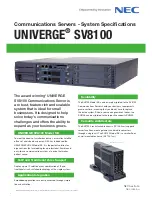
1.8 Using the Unified Messaging Features
1.8.1 What is the Unified Messaging system?
Introduction to the Unified Messaging system
Your PBX can provide you with Unified Messaging system service. You or an outside party can access the
Unified Messaging system from a telephone. As the owner of a mailbox, you can:
•
Send a message to one or more people inside or outside your office.
•
Receive and print fax messages.
•
Transfer messages to other subscribers and add your own comments.
•
Access your mailbox and listen to your messages, even when out of the office.
•
Have the Unified Messaging system call or e-mail you when someone leaves you a message.
•
Be notified by the message waiting lamp on your extension when new messages have been recorded in
your mailbox.
•
Screen your calls.
•
Create a set of options and functions exclusive to your mailbox (Personal Custom Service) that can be
selected by your callers.
•
Voice, fax, and e-mail messages can be managed via an e-mail client that supports IMAP4.
•
Many other useful messaging features.
•
PBX users who are assigned a mailbox in the Unified Messaging system are called
subscribers.
•
Hospitality Mode:
If your service mode is set to "Hospitality Mode", available features such as listening to
messages, personal greetings, etc. may be limited according to the COS settings for your
mailbox.
Before You Begin
In order to use the Unified Messaging system as a subscriber, you need to know the following information.
The System Manager can help you if you do not know this information.
•
The extension number that you should dial in order to access the Unified Messaging system.
•
Your mailbox number and extension number (In many cases these are the same number, but it is possible
they are not).
•
Your mailbox password (if set).
•
The System Manager’s telephone number. The System Manager is the person you should refer to when
you have any problems with the Unified Messaging system.
Prompts
Prompts are recorded voice guidance messages that help you set and use Unified Messaging system
features. Prompts also help callers when the system is handing their calls. Depending on how your Unified
Messaging system is programmed, subscribers and callers can select the language they prefer for system
prompts.
<Prompt example>
"To leave a message, press 1."
"Please leave a message at the tone."
"To end recording, hang up or press 1 for more features."
1.8 Using the Unified Messaging Features
106
Operating Manual
Содержание KX-NSX2000
Страница 10: ...Table of Contents 10 Operating Manual ...
Страница 203: ...Table 1 Standard mode 1 14 2 Using the Directories Operating Manual 203 ...
Страница 204: ...Table 1 Standard mode for RU model 1 14 2 Using the Directories 204 Operating Manual ...
Страница 205: ...Table 2 Option mode 1 14 2 Using the Directories Operating Manual 205 ...
Страница 206: ...Table 2 Option mode for CE model 1 14 2 Using the Directories 206 Operating Manual ...
Страница 207: ...Table 2 Option mode for GR model 1 14 2 Using the Directories Operating Manual 207 ...
Страница 250: ...2 2 2 Message Manager Features 250 Operating Manual ...
Страница 288: ...4 1 3 Supervisory Monitor ACD Control 288 Operating Manual ...
Страница 314: ...Note 314 Operating Manual ...
















































